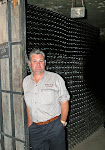Well your concerns may not be unfounded.
A recent industry report flagged up a frightening statistic - there are currently an estimated 3000 second la
 bels floating around the worlds wine racks.
bels floating around the worlds wine racks.So what is a second label? Lets be clear, it is not a second wine. Merely a bottle with a differently designed label to disguise the fact that there are thousands of wines on sale in the high street that are exactly the same in every detail. Except for the name and the price - yep, the price.
Second labels are a valuable, cost effective tool for the the majors to make more money without over stocking. It enables them to widen their range of wines and spread it out around different stores, without actually having to buy new wines from different growers. There are many growers that will quite happily label many of their wines to suite your requirements. Therefore if you have a chain of shops you can label the same wines to suite the expectations of your clientele. For example if you have two shops, one in a fairly affluent area and one in an area where the customers are a bit more price sensitive. You can label the same wine differently to appeal to both sets of customers.
It also enables you to charge a £1 or so extra depending on what you think it will bear.
It is a useful tool for the majors who stock their wine departments according to the demographic of each particular stores customer base. It also enables the producers or their agents to sell the same wine to different companies without conflicting overlaps.
Is it illegal? No it certainly is not. There are strict EU laws governing the labeling of wine.
According to the Food standards Agency these are the legal requirements.
'Specific mandatory items must be shown, in one field of vision. These include nominal volume (eg 75cl), alcoholic strength (eg 11.5% vol), bottler's details, country of origin, type of wine. In addition a statement about the sulphur dioxide content will be required on any label when this exceeds 10mg/litre.'
That is all you legally need to have on the wine label and it doesn't even need to be on the front label. It is perfectly OK to print all this info on a back label.
You may now feel as though you've been had but is this any different than buying cheaper own brand products rather paying more for the leading brand that is made by the same manufacturer? You may well be paying more for the same product because of the way it is dressed up?
A case of 'The King's new clothes' maybe?

